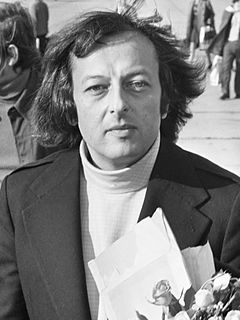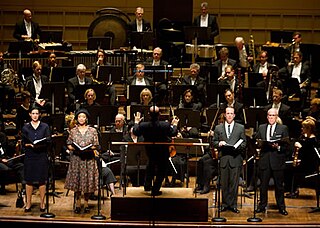Related Research Articles

Johann Strauss II, also known as Johann Strauss Jr., the Younger, the Son, son of Johann Strauss I, was an Austrian composer of light music, particularly dance music and operettas. He composed over 500 waltzes, polkas, quadrilles, and other types of dance music, as well as several operettas and a ballet. In his lifetime, he was known as "The Waltz King", and was largely responsible for the popularity of the waltz in Vienna during the 19th century. Some of Johann Strauss's most famous works include "The Blue Danube", "Kaiser-Walzer", "Tales from the Vienna Woods", and the "Tritsch-Tratsch-Polka". Among his operettas, Die Fledermaus and Der Zigeunerbaron are the best known.
The Los Angeles Philharmonic, commonly referred to as the LA Phil, is an American orchestra based in Los Angeles, California. It has a regular season of concerts from October through June at the Walt Disney Concert Hall, and a summer season at the Hollywood Bowl from July through September. Gustavo Dudamel is the current Music Director, Esa-Pekka Salonen is Conductor Laureate, Zubin Mehta is Conductor Emeritus, and Susanna Mälkki is Principal Guest Conductor. John Adams is the orchestra's current Composer-in-Residence.

André George Previn was a German-American pianist, composer, arranger, and conductor.

"The Blue Danube" is the common English title of "An der schönen, blauen Donau", Op. 314, a waltz by the Austrian composer Johann Strauss II, composed in 1866. Originally performed on 15 February 1867 at a concert of the Wiener Männergesangsverein, it has been one of the most consistently popular pieces of music in the classical repertoire. Its initial performance was considered only a mild success, however, and Strauss is reputed to have said, "The devil take the waltz, my only regret is for the coda—I wish that had been a success!"

Wein, Weib und Gesang , Op. 333, is a Viennese Waltz by Johann Strauss II. It is a choral waltz in its original form, although it is seldom heard in this version today. It was commissioned for the Vienna Men's Choral Association's so-called Fools' Evening on 2 February 1869 with a dedication to the Association's honorary chorus-master Johann Herbeck. Its fanciful title was drawn from an old adage: "Who loves not wine, women and song remains a fool his whole life long."
Liebeslieder op. 114 is a waltz by Johann Strauss II written in 1852. At the time it was conceived, the waltz was titled 'Liebesgedichte' or "Love Poems" and during its first performance, it was even announced as 'Liebesständchen' or "Love Serenade". The first performance was at the famed Vienna Volksgarten on 18 June 1852 under the composer's direction.

Wiener Blut Op. 354 is a waltz by Johann Strauss II first performed by the composer on 22 April 1873. The new dedication waltz was to celebrate the wedding of the Emperor Franz Joseph I's daughter Archduchess Gisela Louise Maria and Prince Leopold of Bavaria. However, the waltz was also chiefly noted by Strauss' biographers as the début of Strauss with the Vienna Philharmonic Orchestra where for many years, the Philharmonic had dismissed any association with the 'Waltz King' as it had not wished to be associated with mere 'light' or 'pops' music. The festival ball celebrating the event was held at the Musikverein Hall which is the venue for the present day Neujahrskonzert.

Steven Edward Stucky was a Pulitzer Prize-winning American composer.
A waltz, probably deriving from German Ländler, is dance music in triple meter, often written in 3
4 time. A waltz typically sounds one chord per measure, and the accompaniment style particularly associated with the waltz is to play the root of the chord on the first beat, the upper notes on the second and third beats.

Manfred Honeck is an Austrian conductor and the Music Director of the Pittsburgh Symphony Orchestra since the 2008/2009 season. In 2018, he was named Artist of the Year by the International Classical Music Awards. On January 28, 2018, Honeck and the PSO were awarded the 2018 Grammy Award for Best Orchestral Performance for their recording of Shostakovich’s Symphony No. 5 and Barber’s Adagio for Strings. The recording won a second Grammy for Best Engineered Album.
Horacio Gutiérrez is a Cuban-American virtuoso classical pianist known for his performances of works in the Romantic Repertoire.

The Burleske in D minor is a composition for piano and orchestra written by Richard Strauss in 1885-86, when he was 21.
Ernest Martin Fleischmann was a German-born American impresario who served for 30 years as executive director of the Los Angeles Philharmonic, which he upgraded to become a top-ranked orchestra. A talented musician, he chose a career on the business aspect of music, rather than a life as a conductor.
The Second Concerto for Orchestra is a concerto for orchestra by the American composer Steven Stucky. The work was commissioned by the Los Angeles Philharmonic while Stucky was their composer-in-residence for the inaugural season of the Walt Disney Concert Hall. It was completed in 2003 and was first performed on March 12, 2004, with the conductor Esa-Pekka Salonen leading the Los Angeles Philharmonic. The piece was awarded the 2005 Pulitzer Prize for Music.
Silent Spring is a 2011 symphonic poem for orchestra by the American composer Steven Stucky. The piece was written to commemorate the fiftieth anniversary of the environmental science book Silent Spring by Rachel Carson and was commissioned by the Pittsburgh Symphony Orchestra in collaboration with the Rachel Carson Institute at Chatham University. The work was premiered in Pittsburgh on February 17, 2012, with the Pittsburgh Symphony Orchestra conducted by Manfred Honeck.
Jeu de timbres is a single-movement orchestral composition by the American composer Steven Stucky. The work was commissioned by the National Symphony Orchestra and completed in late 2003. It was premiered in January 2004, with the National Symphony Orchestra performing under conductor Leonard Slatkin.
Son et lumière is a symphonic poem by the American composer Steven Stucky. It was commissioned by the Baltimore Symphony Orchestra and composed between June and December 1988. The work was premiered in Baltimore by the Baltimore Symphony Orchestra under conductor David Zinman, May 18, 1989.
The Concerto for Orchestra No. 1 is a concerto for orchestra by the American composer Steven Stucky. The work was commissioned by the Philadelphia Orchestra with contributions from Johnson & Higgins for the bicentennial of the United States Constitution. It was composed from September 1986 through April 1987 and premiered October 27, 1988, with the Philadelphia Orchestra performing under conductor Riccardo Muti.
The Violin Concerto is a concerto for violin and orchestra by the American composer Mason Bates. The work was commissioned by the Pittsburgh Symphony Orchestra and violinist Anne Akiko Meyers. It was premiered December 7, 2012, with Meyers and the Pittsburgh Symphony performing under conductor Leonard Slatkin.
The Concerto for Two Flutes and Orchestra is a composition for two flutes and orchestra by the American composer Steven Stucky. The work was commissioned by the Los Angeles Philharmonic, for which Stucky was formerly composer-in-residence and then New Music Adviser. The piece was composed from October through December 1994 and was given its world premiere in Los Angeles by the Los Angeles Philharmonic under the conductor Esa-Pekka Salonen on February 23, 1995.
References
- 1 2 3 Stucky, Steven (1986). Dreamwaltzes: Program Note by the Composer. Retrieved June 16, 2016.
- ↑ Swed, Mark (February 16, 2016). "How unlikely Steven Stucky proved indispensable to the L.A. Philharmonic's rise". Los Angeles Times . Retrieved June 16, 2016.
- ↑ Smith, Harrison (February 15, 2016). "Steven Stucky, Pulitzer Prize-winning composer of intricate musical wit, dies at 66". The Washington Post . Retrieved June 16, 2016.
- ↑ Bernheimer, Martin (November 14, 1987). "MUSIC REVIEW : Previn Makes Much of Dreamy Waltzes, Technicolored Gush". Los Angeles Times . Retrieved June 16, 2016.
- ↑ Kanny, Mark (September 24, 2011). "Review: Pittsburgh Symphony Orchestra waltzes into new season". Pittsburgh Tribune-Review . Retrieved June 16, 2016.
- ↑ Rockwell, John (April 28, 1989). "Review/Music; Slatkin Leads the St. Louis In the Shostakovich 10th". The New York Times . Retrieved June 16, 2016.